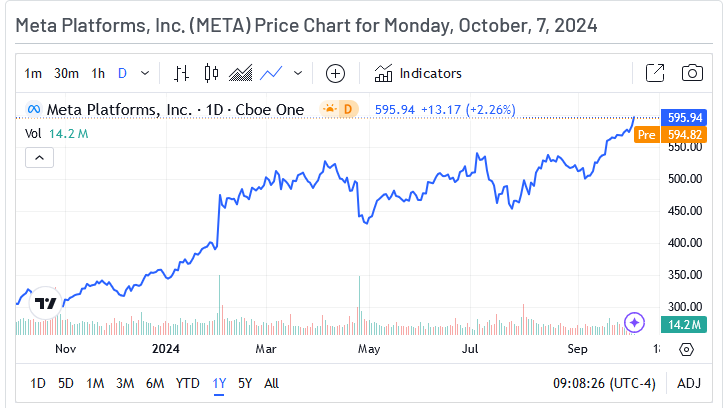- Meta's new headsets and glasses impressed the market and consumers alike at its Connect event.
- However, the company is losing billions on these products, but shares are still up 66% this year.
- The Meta's advertising business is so powerful that it can support these massive losses.
Last week, Meta (NASDAQ:META) made headlines due to the unveiling of several new products. Following the announcement, shares of Meta rose to a new all-time high. Since then, a slew of Wall Street analysts have raised their price targets on the tech company. I’ll dive into Meta’s new products and how they might affect the financials. I'll also detail the other exciting part of Meta's business that is driving growth.
Meta’s New Products Are a Mid-Term Loss, but Could Payoff Huge
Meta's Quest 3 mixed reality headset and second-gen Smart Glasses, made with Ray-Ban, turned heads last week. The Meta Quest 3 competes directly with Apple’s NASDAQ: AAPL Vision Pro Headset. However, there is one massive difference: price. The Apple (NASDAQ:AAPL) Vision Pro starts at an astounding $3,499. The Quest 3s costs $299.
The 3s is the cheaper version of the company’s Quest 3 product, which sells for $499. It came out around the same time last year. The Ray-Ban Smart Glasses look similar to traditional sunglasses. The new second-generation version has Meta AI. It lets users voice-command the glasses without needing their phone.
These products are in Meta's "reality labs" segment. However, the financial results show that the company is losing big on them. Over the last twelve months, revenue of just over $2 billion in this segment has resulted in a segment operating loss of over $16 billion. That’s an operating margin of negative 800%. Due to now undercutting Apple even more, this margin isn’t likely to improve.
The Quest 3 was already massively beating Apple’s headset sales. Reports suggest Meta has sold around 1.2 million units, while Apple has yet to reach 100,000. Still, Apple is almost certainly actually making money from its products.
Overall, Meta believes in the future of this technology and is willing to take a loss on it for years to come. Meta is choosing to stay at the forefront of this space. If consumer adoption ever becomes high enough to be profitable, Meta's commitment to the space should make it a big winner. However, it can only lose so much money on this business due to its other, very successful business.
Meta's Quest 3 mixed reality headset and second-gen Smart Glasses, made with Ray-Ban, turned heads last week. The Meta Quest 3 competes directly with Apple’s NASDAQ: AAPL Vision Pro Headset. However, there is one massive difference: price. The Apple Vision Pro starts at an astounding $3,499. The Quest 3s costs $299.
The 3s is the cheaper version of the company’s Quest 3 product, which sells for $499. It came out around the same time last year. The Ray-Ban Smart Glasses look similar to traditional sunglasses. The new second-generation version has Meta AI. It lets users voice-command the glasses without needing their phone.
These products are in Meta's "reality labs" segment. However, the financial results show that the company is losing big on them. Over the last twelve months, revenue of just over $2 billion in this segment has resulted in a segment operating loss of over $16 billion. That’s an operating margin of negative 800%. Due to now undercutting Apple even more, this margin isn’t likely to improve.
The Quest 3 was already massively beating Apple’s headset sales. Reports suggest Meta has sold around 1.2 million units, while Apple has yet to reach 100,000. Still, Apple is almost certainly actually making money from its products.
Overall, Meta believes in the future of this technology and is willing to take a loss on it for years to come. Meta is choosing to stay at the forefront of this space. If consumer adoption ever becomes high enough to be profitable, Meta's commitment to the space should make it a big winner. However, it can only lose so much money on this business due to its other, very successful business.
A large part of Meta’s investments in AI is going toward improving the ability of its advertisements to reach the right customers. When it comes to actual versus theoretical implementation of AI, this is a use case that makes incredible real-world sense right now. Meta’s family of apps, which includes Facebook and Instagram, has 3.3 billion daily active people (DAP). That’s approximately 40% of the world's population. And despite being around for a long time, these apps continue to add users; DAP grew by 7% last quarter. With the incredible amount of data Facebook has on its users, integrating AI can create extremely personalized ads.
This increases the efficiency of the marketing spent by the companies that use Meta’s platform. In business, acquiring new customers is arguably the most important and difficult task. Meta’s ability to make this easier for companies means they’ll be willing to spend big-time marketing on Meta. It also gives the company pricing power.
The price of each of its ads increased by 10% last quarter, which shows that the company is growing and increasing its margins simultaneously. Its operating margin for the segment increased by a whopping 876 basis points last quarter.
Wall Street Boost Targets Show Solid Upside After Product Releases
Overall, I believe Meta is in an extremely strong position in the near term, supported by its advertising business. Additionally, the company has potentially massive long-term growth capability revolving around its consumer products. Improvements in profitability for this segment would be a big plus for the company. The average analyst price targets since the Connect event suggest a 14% potential upside for the stock.
